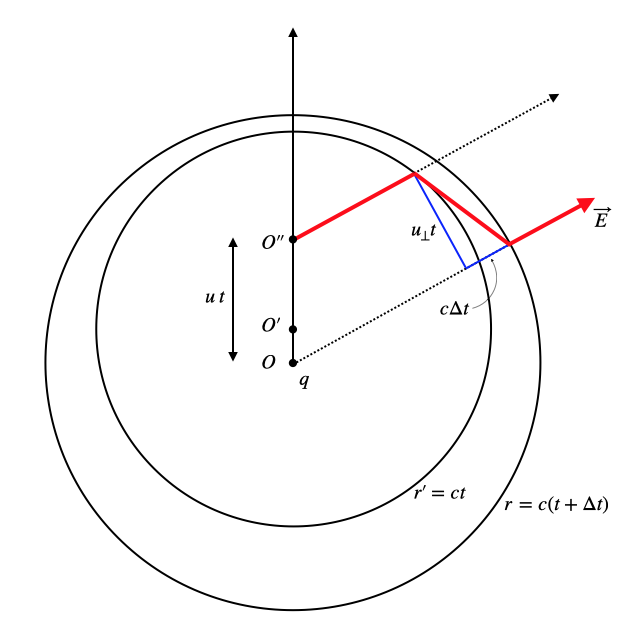This page was generated from `/home/lectures/exp3/source/notebooks/L18_AMA/Dipole Radiation.ipynb`_.
Dipole Radiation¶
We would like to have a look at the origin of electromagnetic radiation in a classical picture. Especially we woul like to understand, why the electromagnetic fields that are radiated are transverse to the direction of propagation. We will consider for this purpose the radiation generated by an accelerated charge.
Electric field of an accelerated charge¶
We will follow for the derivation of transverse electric field the basic steps of the derivation by Larmor. We consider a charge, which is initally at rest in the point

Fig.:
What will be important for our consideration is the fact that any information about a systems change of state is limited in its propagation to the speed of light. Thus, the information that the charge
Consider now the field line of the electric field that exists outside the outer circle which would trace back to point
The bend part of the field vector can be decomposed into a field component perpendicular (
The ratio of perpendicular and parallel component is then given by
where the ratio of the electric fields is the same as of the velocity components. The velocity
where we replaced the time
This electric field that is generated is now not anymore radially poiting outwards from the soucre, but it is tengential to a sphere around
and thcorresponding magnetic field as
where
Note that in the above equation the electric field is observed at time
Energy flow¶
With the help of the poyting vector
we may now have a look at the energy flow from the accelerated charge. Since the electric and the magnetic field are orthogonal we can readily obtain the magnitude of the Poynting vector
from which now follows with
or
The total power that is then radiated by the accelerated charge is the given as the integral of the Poynting vector over a closed surface around the charge, i.e.
which upon integration finally yields Larmors formula
This is the total radiated power of an accelerated charge.
Oscillating Dipole¶
With the previous section we are now ready to have a look at a situation, where the charge is oscillating, for example, around a fixed positive charge. This situation can occur when an atom is polarized by teh electric field of an incident light wave. Since this electric field is in the visible range of a wavelength much longer than the size of the atom, we may consider the atom as being in a homogeneous oscillating electric field as we did already earlier. This approxiamtion is called the
Rayleight limit and the process is termed Rayleigh Scattering. Lets assume the charge is oscillating at a frequency
from which we obtain the velocity
and finally the required acceleration
The product of charge and acceleration which enters the generated electric field can then be expressed as
since the dipole moment is given by
The direction of the electric and also the magnetic field can now be constructed with the appropriate unit vector in the radial direction as well as the direction of the dipole moment
This corresponds to the radiated field of an oscillating dipole at large distances (
With the help of the dipole field we thus obtain the intensity radiated by an oscillating dipole at
and the radiated power is given by
As frequecies not go as easily in our daily color language, we have converted that expression to contain the wavelength of light, which tells us, that the power radiated scales with the inverse of the wavelength to the power of four. This means for the visible light, that blue light is scattered much stronger than red light.
